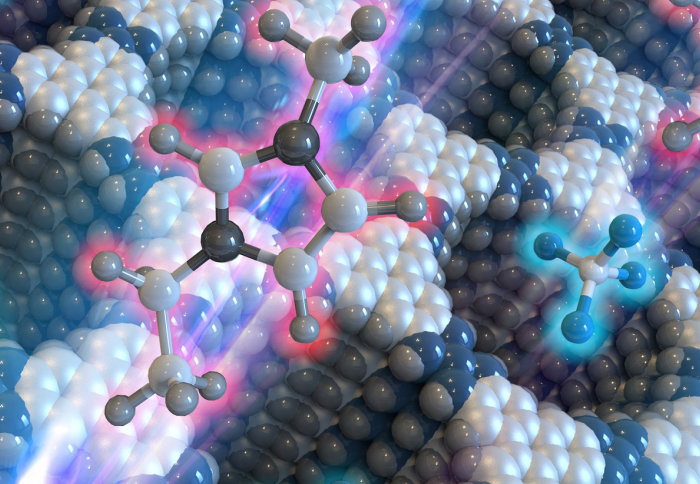Smart design of new materials could improve energy storage technologies

Materials that can be precisely designed at the nanoscale could allow ‘supercapacitors’ to store more energy while maintaining their fast charge time.
Researchers from the Huazhong University of Science and Technology, Imperial College London and the Massachusetts Institute of Technology performed simulations and experiments that show special electrode materials could be precisely engineered to produce supercapacitors that charge quickly and store more energy.
Our work shows that the use of MOFs as electrodes can provide exceptional performance, balancing energy storage and power delivery in supercapacitors. Professor Alexei Kornyshev
The materials are metal–organic frameworks (MOFs), which can be used to build 3D conducting scaffolds with abundant small holes or ‘pores’. It’s this ability to finely tune the materials that the researchers show could be exploited to make even more efficient energy storage technologies.
Traditional batteries store a relatively large volume of energy, but take a long time to charge and discharge, and can only tolerate a certain amount of charging and discharging before losing performance.
Supercapacitors, a related technology, can charge and discharge very quickly and cope with many more cycles, but have poorer energy storage volume.
They are currently used for rapid energy exchange, such as regenerative braking in cars, where the energy of braking is temporarily stored and used to help power the car forward. They are already used in public trams in China, where they are charged during short stops and use that energy when driving.
Seeking new materials
Both batteries and supercapacitors use electrodes – solid surfaces that store electricity by attracting oppositely charged ions from liquids called electrolytes that fill the capacitor. The ions are stored in the pores – so more pores mean more capacity to store energy.
Supercapacitors have so far been unable to compete with batteries on energy storage, meaning their use is limited. But new electrode materials with abundant pores could elevate the amount of stored energy in supercapacitors, leading to the expanded use of fast-charging supercapacitors instead of batteries, for example in electronic devices.
Now, in a paper in Nature Materials, the international team have investigated using electronically conducting MOFs as electrode materials, combined with ionic liquids – electrolytes composed exclusively of large ions. MOFs contain regular patterns of very well-defined pores that can store ions and molecules.
The abundance of pores means MOFs can store a huge number of ions, meaning they offer the potential to make supercapacitors that store more energy per weight or volume. The use of ionic liquids also means the voltage applied during charging can be raised without causing electrochemical reactions that lead to device degradation. This allows a further increase in the stored energy capacity.
MOFs’ well-ordered structures also help researchers better understand the underlying charging mechanisms.
Balancing storage and power
Co-author of the study Professor Alexei Kornyshev, from the Department of Chemistry at Imperial, said: “Current technologies are limited by either having large energy storage or fast charging. Our work shows that the use of MOFs as electrodes can provide exceptional performance, balancing energy storage and power delivery in supercapacitors.
“The use of MOFs for supercapacitors was pioneered at MIT, but their combination with ionic liquids, and the molecular insight into the functioning of such supercapacitors is what makes this work a unique step forward.”
The team used a ‘computational microscopy’ approach to model the molecular interactions inside the MOFs with ionic liquid electrolytes. Major simulations were performed by Sheng Bi of the group of Professor Guang Feng at HUST in Wuhan, a PhD student shared between HUST and Imperial.
The team then tested the predictions of the model using lab experiments at MIT and HUST, which matched the predictions well. This means their understanding of the capacitance and dynamics of the MOFs and electrolytes should be good enough to design even better performing MOFs.
Professor Kornyshev added: “Our modelling approach provides us with an opportunity to simulate the performance of MOF electrodes with high precision, which enables further rational design of such electrodes.”
Professor Feng commented: “It will be most interesting to go from testing the powder MOF-electrodes we used to fully single-crystal MOF structures.”
The team are now searching for combinations of MOF designs and electrolytes that will hold even more power without causing chemical reactions in the MOFs.
Funding for the research came from the National Natural Science Foundation of China, the Leverhulme Trust, and the Imperial College-MIT seed fund.
-
‘Molecular understanding of charge storage and charging dynamics in supercapacitors with MOF electrodes and ionic liquid electrolytes’ by Sheng Bi et al. is published in Nature Materials.
Article supporters
Article text (excluding photos or graphics) © Imperial College London.
Photos and graphics subject to third party copyright used with permission or © Imperial College London.
Reporter
Hayley Dunning
Communications Division